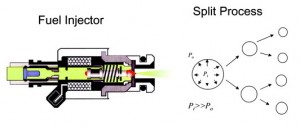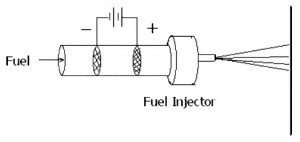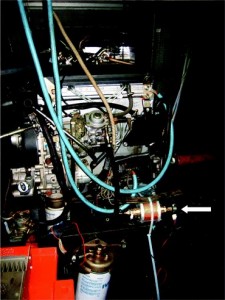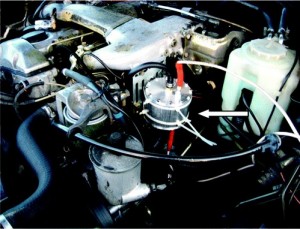Oct
1
Reality Check – A New Fuel Saving Device
October 1, 2008 | 9 Comments
Rongjia Tao and colleagues Huang, Tang and Bell at Temple University in Pennsylvania will report in a study scheduled for the 19 November issue of the journal Energy & Fuels, that they have developed a small electrorheological device used by insertion into the fuel line near the fuel injector, which can improve fuel economy.
That’s enough to send this skeptical cynic right up the tree in suspicion. But . . .
It’s a rare thing indeed to see a university sponsored research program run by competent and innovative researchers hit what might be a home run that will publish in a reviewed journal.
The device creates an electric (electro rheology) field that reduces fuel viscosity, so enabling the injection of smaller droplets into the engine. Smaller fuel particle surfaces are closer to the oxygen and can react more quickly with the reactions completing the oxidation more fully. “Injected fuel has a pressure higher than that in the combustion chamber. The droplets are thus split, becoming smaller and smaller after they are emitted from the nozzle. However, in reality, the fuel droplets can never reach equilibrium because the fuel’s natural viscosity acts against any deformation of the droplets,” state the authors in the pre-press paper release.
They further explain, “The fuel flows through two metallic meshes before it reaches the fuel injector. A voltage is applied on the two meshes to produce an electric field of around 1.0 kV/mm between the two meshes. The device consumes very low electric power, less than 0.1 W. In our setup, the rheologic field direction is opposite the flow direction, which may help to provide negative charges to the fuel droplets. However, the main function of our device is to reduce the viscosity of the fuel as it passes the electric field.” The key is to get the fuel negatively charged, as fuel particle sizes will be small if their charge density is high, and no fuel agglomeration can occur because the negatively charged droplets repel each other. This key of chemistry is the point that kills the skepticism. Gee, if I weren’t so impressed by the innovation of putting the field in the fuel so making it a rheological procedure, rather than around it as with so many electromagnetic devices from the past or ideas about electrostatic atomization that may or may not prove practical, it would be just another dreamy idea.
The team started testing by spraying fuels with injectors on oxidized magnesium plates thick enough, large enough and far enough away that individual fuel particles could be examined. The method catches all the fuel sprayed so showing the particle sizes over some 50 tests are quite smaller especially for diesel fuel.
Going to the next step the team made up a test rig and installed it in the fuel system of diesel engine provided by Cornaglia Iveco of Italy who performed the first test at 1.3 kV/mm flowing exposed to the field for about a second. This test yielded about a 5.5% efficiency improvement going from 38% to 40.1%. What was learned was that using the device such that the field running parallel with the flow for a period of about a second the efficiency still held to a 4.7% improvement.
The next step was to perform tests in house with more experimentation of the settings in power, time, and polarity. While the paper doesn’t list the settings chosen, the authors point out that the in house test with a Mercedes engine described as “typical” shows a dynamometer measured output at essentially identical fuel rates yielding an improvement of 20.4% with a 5 second fuel time in the field at 1 kV/mm. But what throws me off is the quoted fuel rates at 500 grams per hour and horsepower at only 0.3677 and 0.4428 from a Mercedes 300D engine. Something is way off here.
But the team has used the 300D for over 6 months on the road. With the ability to switch the device on and off they are able to document fuel use increases from 32 miles per gallon up to 38 in highway use and a 12 –15% improvement in city driving conditions. These real world measurements over a long period help with the credibility. But I just have to think that Mercedes is making more than 0.3677 hp, don’t you?
What is new is this writer, who has to date no confidence in the stream of accessory type things to buy to increase fuel efficiency, is a large dose of believability. Before I just didn’t bother, and just barely looked into this. While I’m still suspicious, not convinced, or sold I do wish to see fuel pre preparation investigated as I do understand the optimizing the fuel and oxygen conditions and ignition can have substantial impacts on the overall engine efficiency. It is also necessary, in my view, to achieve the lean burn conditions that might lead to better overall thermal efficiency.
It’s a real fuel pre preparation device that has a demonstrable effect. Now for some third party verification, more testing, exploring of settings and applications beyond diesel and ethanol blended gasoline. Something is definitely up here and deserves a congratulatory signal, more funding and as successes and more understanding becomes available, widespread adoption through efforts to produce reliable low cost systems for hundreds of millions of vehicles worldwide.
This is top form innovation and I wish the group continued success.
Comments
9 Comments so far






Keep on trying. You also want to try it in conjunction with Spiralmax.com products. Make sure you have a baseline so when combined you know the level of improvement.
LOL… Spiraljunk.com – Plugging another “scam” fuel saving device (Google it…) won’t help the development of a device that may actually work… rather spiraljunk is just another marketing gimmic to be added the useless collection of magnetic, sonic, brown’s gas.. etc fuel saving devices that uninformed consumers wind up paying $$$ for. Shame on you Bob…
[…] Welcome to EM! I googled "temple university fuel saving device" and found these URLs : Reality Check – A New Fuel Saving Device | New Energy and Fuel […]
[…] to it. this may very well get me the other 3 mpg I want without removing the lift and big tires. Reality Check – A New Fuel Saving Device | New Energy and Fuel btw… my buddy has an 07 with the same motor as mine (LBZ) and he regularly travels 120 miles at […]
[…] alot of promise. I could really enjoy another 3mpg. This looks like it could be low hanging fruit! Reality Check – A New Fuel Saving Device | New Energy and Fuel __________________ 06 LBZ 2500 4×4 6" fabtech lift Ranch hands front/back 35" BFG MTs […]
This is a first class scam. However I am not sure whether Dr. Tao, a physics professor with no previous interest in internal combustion engines, had been taken advantage of by STWA people and got the “study” published in the well-known scholarly journal Energy and Fuels. But the story is not over yet. A university of Toronto combustion professor wrote a Comment on Tao’s paper claiming that laws thermodynamics are violated. See “Gulder “Comments on Electrorheology Leads Efficient Combustion by Tao et al.” Energy and Fules, ASAP in press (doi:10.1021/ef800829v). Prof. Gulder’s Comment can be accessed at http://arrow.utias.utoronto.ca/~ogulder/Z_Energy&Fuels2009comb_eff.pdf
Wow this is a great resource.. I’m enjoying it.. good article
ЎHola!
Es conforme, su pensamiento simplemente excelente
[url=http://ss20.myftp.org/]BernieR[/url]
Well it’s 2014 now. What’s happened to this?